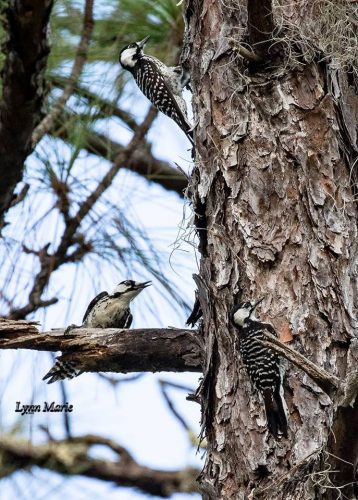As you saunter through a longleaf pine forest, tortoises feeding on wiregrass and other herbaceous plants of the open forest floor pay you little mind if you are lucky. If the forest has been able to have fire keep it clean. If there are enough old-growth longleaf pines present to sustain them. If all these things are in your favor, you may be lucky enough to see this little gem.
The red-cockaded woodpecker (Leuconotopicus borealis) is an endangered species across its remaining range. Once found from Florida north to New Jersey and Maryland and west to the eastern parts of Texas and Oklahoma, they are now extirpated from Kentucky, Maryland, Missouri, New Jersey, and Tennessee. There are now just over 14,000 estimated individuals in 5,627 known groups left in their shrunken range.
There are a few species that look similar to the red-cockaded woodpecker. One good way to identify this species is by the large, white cheek patch on each side of the head. In males, this patch will have a very small, almost invisible red streak on each side of the white patch (the cockade). They feed on small insects such as grasshoppers, roaches, ants, beetles, caterpillars, and some berries.
Unlike other woodpecker species, the red-cockaded woodpecker nests only in live, old-growth pine trees infected with red heart fungus. This fungus makes the wood softer for cavity construction. It can take up to two years to construct a cavity, and a breeding group, or cluster, will have multiple nest cavities in their home range. The red-cockaded woodpecker is a cooperative breeder with a breeding pair and several helper birds that are usually sons from prior hatches. The breeder male will also drill holes under the nest cavity to cause the pine to produce sap flows. This helps prevent nest-raiding snakes from entering the hole.
Why did this species decline? Why are they endangered? This species requires old-growth longleaf pine forests that experience frequent fires, which keep the forest floor clean and open. That type of forest is among the most endangered ecosystems in the world. Only 3% of the longleaf pine forests remain. Loss of habitat, and the fire suppression policies of the recent past, have combined to cause their rapid decline.
BUT……. it’s not all bad news! Through the hard work of hundreds of forest rangers and biologists, there is a population increase in the red-cockaded woodpecker. Restoring the pine forests, returning fire, and carefully relocating individuals to new, healthy forests have helped this species increase its population. They are not in the clear yet, but with the continued hard work and efforts of these dedicated individuals, this species will delight for generations to come.
Imagine Our Florida would like to thank one of our members, Lynn Marie, for providing these wonderful images she captured in The Ocala National Forest!

